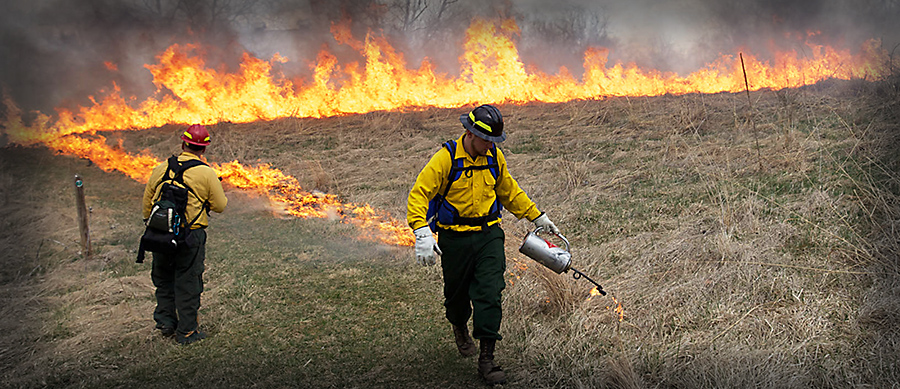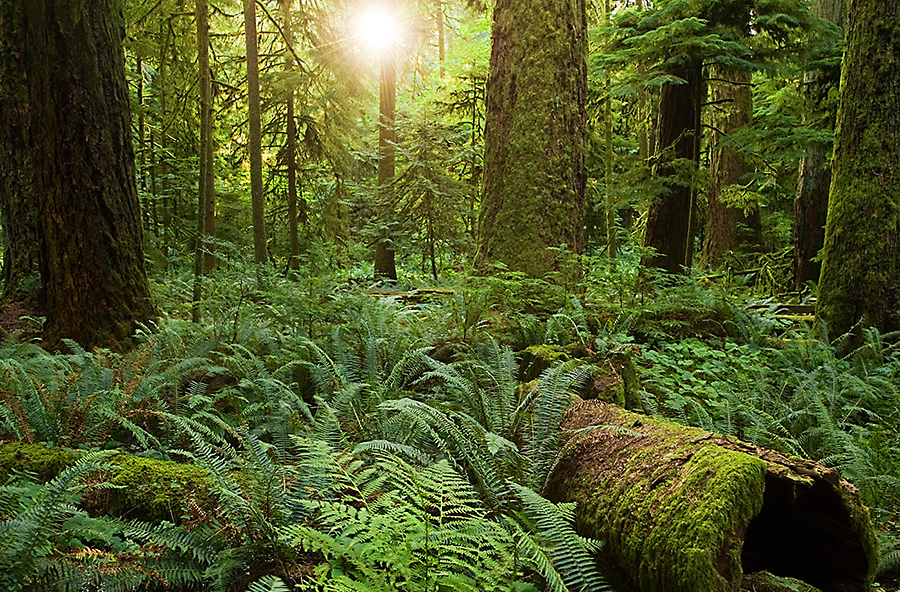Ecosystem‐Level Conservation

Objectives
In the late twentieth century, the scope of conservation broadened from individual species to biodiversity as a whole. This led to the development of ecosystem approaches to conservation, often referred to as “coarse-filter” or “landscape-level” methods (Hunter et al. 1988). The new emphasis on ecosystems was, in part, a necessity born of the impracticality of extending the focal species approach to the myriad species comprising biodiversity. A broad-brush approach was needed. In addition, ecosystems were themselves recognized as a component of biodiversity that merited conservation.
Ecosystems can be defined at multiple scales (e.g., a single bog or an entire forest) and they often blend seamlessly from one to the next (e.g., short grassland to tall grassland). Therefore, ecosystems do not constitute discrete targets for conservation the same way that species do. In practice, we delineate ecosystems using classification systems tailored to specific management applications. In many cases, ecosystem-level conservation measures are applied using administrative boundaries, without regard to the ecosystem types involved.
We will begin this chapter with a discussion of the objectives of ecosystem-level conservation. We will then turn to applied conservation methods and their theoretical foundations. Because most ecosystem-level conservation measures are delivered as part of sector-specific resource management programs, our discussion of conservation methods will be organized by industrial sector. At the end of the chapter, we will examine integrated approaches to land management.
As with the last chapter, we will concentrate on conventional conservation approaches, leaving the accommodation of climate change to Chapter 9. The planning and management of protected areas will also be treated as a separate topic, in Chapter 8.
What Are We Trying to Achieve?
The fundamental goal of conservation is to maintain biodiversity. This implies there is a reference state that we hope to perpetuate or restore. But what exactly is this state?
In general terms, the reference state is usually described as a system under natural conditions. The Oxford English Dictionary defines “natural” as “not made or caused by humankind.” This definition places us in the right vicinity but lacks specificity. Natural landscapes change over time, so there are many versions of “natural” to choose from. It is also unclear how the ecological effects of Indigenous peoples are to be handled (Bjorkman and Vellend 2010). It seems inappropriate to treat ancient hunter-gatherers apart from nature.
What is missing from the dictionary definition of “natural” is context. The “what” of conservation becomes clear once we understand the “why.” As recounted in Chapter 2, the modern concept of conservation emerged in the last half of the twentieth century as a societal response to the widespread environmental degradation caused by rapid industrial development. Thus, conservation is fundamentally motivated by a desire to protect biotic systems from anthropogenic threats. And the focus is squarely on the impacts of modern society, not what Indigenous peoples did in the distant past. It follows that the appropriate ecological reference state for conservation is the condition of a species or ecosystem as it would be, today, in the absence of the anthropogenic disturbances we discussed in Chapter 5. When we encounter or use the term “natural” in applied conservation, we should consider it a shorthand label for this ecological reference state (Fig. 7.1).
 |
Fig. 7.1. An old-growth forest on Vancouver Island. This forest has been used for millennia by Indigenous peoples; nevertheless, it serves as a useful baseline for assessing the ecological effects of industrial forestry. Credit: S. Trinh. |
Defining the Ecological Reference State
To serve as a management objective for conservation, the ecological reference state must be quantified across all the constituent elements of biodiversity. At the ecosystem level, the relevant components are composition, structure, and function (Wurtzebach and Schultz 2016). Ecosystem composition refers to the variety and abundance of species in a given system. Structure refers to the spatial arrangement of ecosystem components across multiple scales. For example, in forested landscapes, local-scale structure includes the three-dimensional physical structure of a forest stand, and landscape-scale structure includes the mosaic pattern created by the spatial arrangement of individual stands (Shorohova et al. 2023). Function refers to the ecological processes characteristic of living systems, such as succession, nutrient cycling, predator-prey dynamics, and dispersal.
When quantifying the ecological reference state, it is important to recognize that biotic systems are dynamic. Through natural processes, such as wildfire and animal migration, the elements of a system are in constant flux. Some elements change over the course of the day, some over the course of a year, and others over decades. Consequently, the reference state cannot be captured by a single snapshot in time. Instead, we must characterize the reference state in terms of the natural range of variability (NRV; Keane 2009).
Box 7.1. Ecological Integrity
Ecological integrity is a summary measure that describes the condition of an ecosystem relative to its ecological reference state (Wurtzebach and Schultz 2016). The closer a system is to a pristine condition, the higher its integrity. In practice, ecosystem integrity is used mainly as a concept rather than as a practical assessment tool. This is because ecosystems are too complex to be distilled down to a single summary measure. For applied conservation, we measure indicators of individual ecosystem components and express their status relative to the natural state.
In ecosystem applications, NRV is a statistical summary of the mean and variance of biotic elements and processes in a given area under natural conditions (i.e., in the absence of anthropogenic disturbance). The challenge we face in quantifying NRV is that most management areas are no longer natural (Grondin et al. 2018). In some cases, the NRV for such sites can be extrapolated from measurements taken in a nearby protected area. More often, it must be reconstructed. A common approach is to infer the undisturbed state of a system from what is known about its condition prior to industrial development. This is referred to as the preindustrial baseline approach.
The preindustrial baseline approach will need to be replaced with a more dynamic approach once ecological transitions from climate change become more extensive (Bergeron et al. 2011). For the time being, it remains adequate for managing most near-term threats, such as habitat loss, fragmentation, overharvesting, pollution, and so forth. We will examine climate-ready approaches in Chapter 9. Note that it is not the ecological reference state concept that needs to be revamped, but how we measure it.
In summary, conservation is motivated by a desire to prevent or reverse harm to biotic systems from the activities of modern human society. The ultimate goal is to have these biotic systems as close as possible to their natural state. This state is described by the NRV of ecosystem composition, structure, and function (i.e., the ecological reference state). In most systems, NRV cannot be measured directly because of anthropogenic changes. It must be extrapolated from elsewhere or reconstructed. We will examine how this is done later in the chapter, in the context of specific management applications. Working examples are also provided in the case studies, in Chapter 11.
To be clear, the ecological reference state defines what we would like to achieve from the perspective of conservation. This is not the same as a management target. As we saw in Chapter 6, trade-offs with other land-use objectives also need to be considered, and this generally results in some form of compromise. But it is vital to begin the decision-making process with a clear articulation of what the ultimate objectives of conservation are. This way, the costs and benefits of alternative management approaches can be meaningfully assessed. Moreover, if compromises are necessary, everyone involved will understand exactly what is being given up. This is the essence of robust, transparent decision making.
Rigorous application of the ecological reference state also guards against shifting baselines (also known as the “ratchet” effect; Pauly 1995). Shifting baselines occur when conservation objectives are reset each generation based on prevailing conditions, locking in losses that have already occurred (see Case Study 5).
Box 7.2. The Pitfalls of Using Species Richness in Conservation Applications
Species richness is commonly used to describe biodiversity patterns, but it does not provide a useful baseline for applied conservation (Devictor and Robert 2009; Dornelas et al. 2014). The goal of conservation is to maintain biotic systems as close as possible to the natural state, which means retaining the full complement of native species. Species richness is blind to species composition and only provides the raw number of species in a given area. A study of avian species richness in southern Ontario by Desrochers et al. (2011) illustrates the pitfalls of using species richness as a baseline. Progressive conversion of the natural forest in this region to open lands for agriculture and other human uses resulted in the loss of forest specialist species which was masked by an influx of open-habitat species. The integrity of the original ecosystem was markedly compromised, yet species richness was maintained. A focus on richness could even motivate efforts that are counterproductive. As illustrated by the Ontario example, the most efficient way to maintain species richness is through habitat disturbance, rather than by expending the effort needed to maintain sensitive and rare species. This is entirely contrary to the purpose of conservation, which is to protect natural systems from anthropogenic threats.

